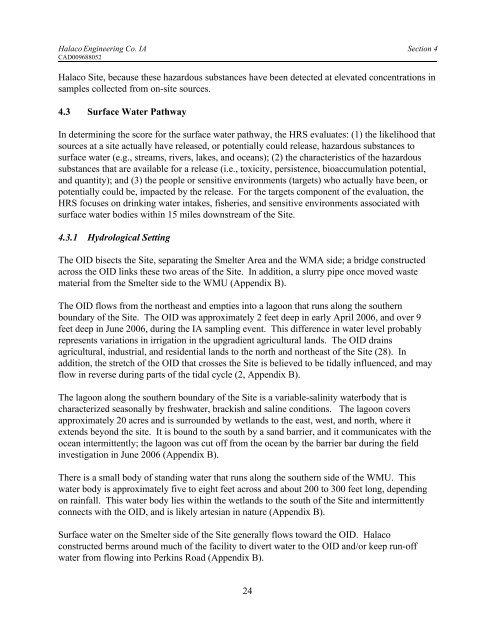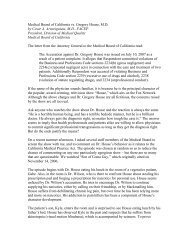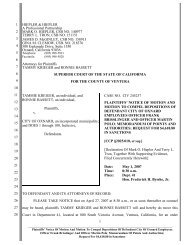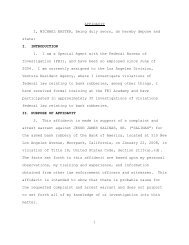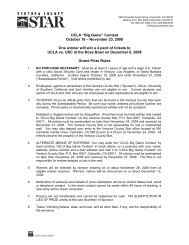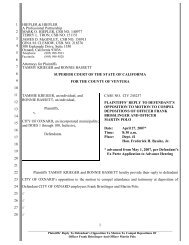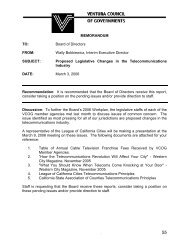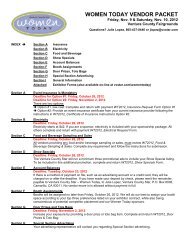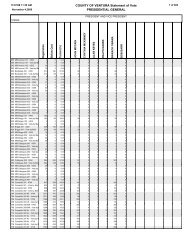Integrated Assessment Halaco Engineering Company ... - Archives
Integrated Assessment Halaco Engineering Company ... - Archives
Integrated Assessment Halaco Engineering Company ... - Archives
Create successful ePaper yourself
Turn your PDF publications into a flip-book with our unique Google optimized e-Paper software.
<strong>Halaco</strong> <strong>Engineering</strong> Co. IA Section 4<br />
CAD009688052<br />
<strong>Halaco</strong> Site, because these hazardous substances have been detected at elevated concentrations in<br />
samples collected from on-site sources.<br />
4.3 Surface Water Pathway<br />
In determining the score for the surface water pathway, the HRS evaluates: (1) the likelihood that<br />
sources at a site actually have released, or potentially could release, hazardous substances to<br />
surface water (e.g., streams, rivers, lakes, and oceans); (2) the characteristics of the hazardous<br />
substances that are available for a release (i.e., toxicity, persistence, bioaccumulation potential,<br />
and quantity); and (3) the people or sensitive environments (targets) who actually have been, or<br />
potentially could be, impacted by the release. For the targets component of the evaluation, the<br />
HRS focuses on drinking water intakes, fisheries, and sensitive environments associated with<br />
surface water bodies within 15 miles downstream of the Site.<br />
4.3.1 Hydrological Setting<br />
The OID bisects the Site, separating the Smelter Area and the WMA side; a bridge constructed<br />
across the OID links these two areas of the Site. In addition, a slurry pipe once moved waste<br />
material from the Smelter side to the WMU (Appendix B).<br />
The OID flows from the northeast and empties into a lagoon that runs along the southern<br />
boundary of the Site. The OID was approximately 2 feet deep in early April 2006, and over 9<br />
feet deep in June 2006, during the IA sampling event. This difference in water level probably<br />
represents variations in irrigation in the upgradient agricultural lands. The OID drains<br />
agricultural, industrial, and residential lands to the north and northeast of the Site (28). In<br />
addition, the stretch of the OID that crosses the Site is believed to be tidally influenced, and may<br />
flow in reverse during parts of the tidal cycle (2, Appendix B).<br />
The lagoon along the southern boundary of the Site is a variable-salinity waterbody that is<br />
characterized seasonally by freshwater, brackish and saline conditions. The lagoon covers<br />
approximately 20 acres and is surrounded by wetlands to the east, west, and north, where it<br />
extends beyond the site. It is bound to the south by a sand barrier, and it communicates with the<br />
ocean intermittently; the lagoon was cut off from the ocean by the barrier bar during the field<br />
investigation in June 2006 (Appendix B).<br />
There is a small body of standing water that runs along the southern side of the WMU. This<br />
water body is approximately five to eight feet across and about 200 to 300 feet long, depending<br />
on rainfall. This water body lies within the wetlands to the south of the Site and intermittently<br />
connects with the OID, and is likely artesian in nature (Appendix B).<br />
Surface water on the Smelter side of the Site generally flows toward the OID. <strong>Halaco</strong><br />
constructed berms around much of the facility to divert water to the OID and/or keep run-off<br />
water from flowing into Perkins Road (Appendix B).<br />
24


